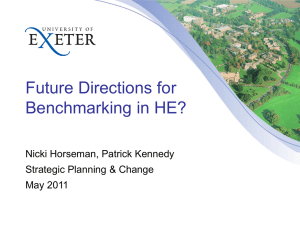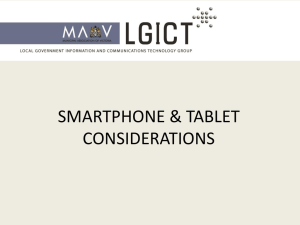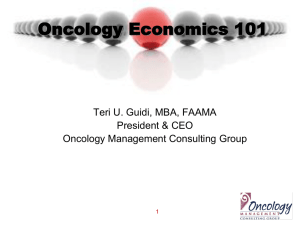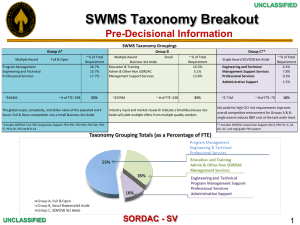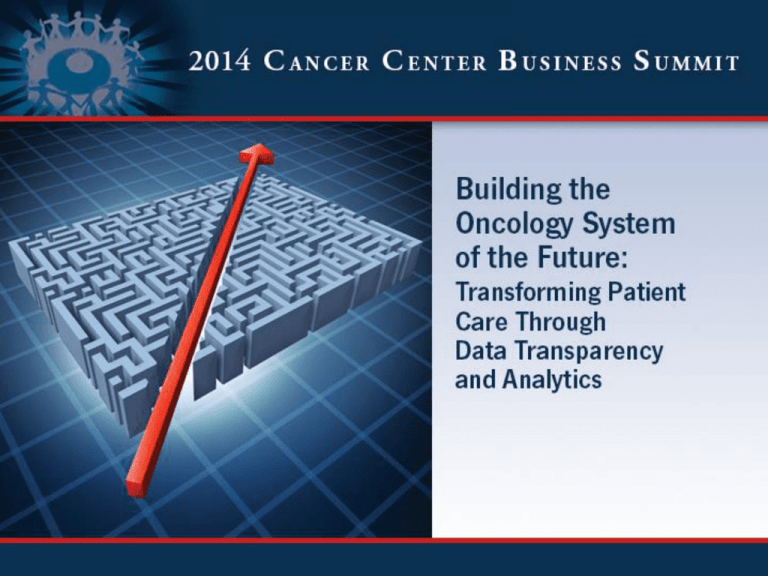
Benchmarking:
If You Can’t Measure It,
You Can’t Manage It.
Teri U. Guidi, MBA, FAAMA
President and Chief Executive Officer
Oncology Management Consulting Group
Elaine L. Towle, CMPE
Director, Consulting Services
Oncology Metrics®, a division of Flatiron
Health, Inc.
Agenda
• 2014 National Hospital Oncology Benchmark Study
• National Practice Benchmark, 2014 Report on 2013
Data
National Hospital Oncology Benchmark Study
• In 2013, and in response to the recurring
requests on list serves, from colleagues and
from clients, OMC Group solicited volunteers
to contribute data for a pilot analysis of
productivity in hospital-based infusion and
radiation centers.
• It was a big hit!
• In 2014, we expanded the number of centers
and the number of data points.
4
2014 Infusion Data Points
•
•
•
•
•
•
•
•
Calendar year 2013 data
Patients per FTE
Encounters per FTE and patient
Chairs per FTE
Active treatment hours per FTE and patient
Drug doses mixed per pharmacy staff
Registry cases per registrar
FTE categories include: nutritionist, financial
counselor, social worker, NPP, LPN/NA, MA, RN,
patient navigator, pharmacist, pharmacy tech, hemeonc.
2014 Infusion Data Slices
• Size of infusion center
• Academic or Community
• Major disease sites
–
–
–
–
–
–
Breast
Colorectal
Lung
Prostate
Benign Hematology
Non-oncology
2014 Data
• 45 infusion centers
• 27 radiation departments
• All billed services for any patient that had activity in the
infusion department
• Unique patient id
• Date of service and diagnosis
• CPT/HCPCS code and billed units
• Tumor registry report
• Program data
– Hours of operation
– Budgeted FTE’s
– Equipment (chairs, linacs, etc.)
– Physicians
7
Caveats
• All centers are coding and billing services
correctly
• All centers code chief complaint in one of the
first 3 ICD-9 positions
• All centers interpreted survey questions
consistently
• Some patients may be counted more than
once in disease-specific data (different
diagnosis at different encounters)
8
Infusion Center Profiles
HID
H66
H45
H47
H65
H55
H48
H56
H54
H53
H41
H42
H08
H68
H36
H57
SMALL CENTERS
ACADEMIC/
INFUSION UNIQUE
COMMUNITY ENCOUNTERS
PTS
C
2
7
C
13
10
C
244
72
C
310
102
C
393
116
C
400
88
C
441
141
C
453
143
C
519
232
A
627
216
A
841
191
C
1049
327
C
1469
189
C
1575
332
C
1832
480
HID
H67
H52
H50
H59
H23
H58
H61
H12
H49
H63
H21
H40
H10
H39
H60
MEDIUM CENTERS
ACADEMIC/
INFUSION UNIQUE
COMMUNITY ENCOUNTERS
PTS
C
1963
322
C
2107
407
C
2156
993
C
2440
637
C
2549
776
C
2954
816
A
3258
265
C
3453
731
C
3518
883
C
3797
1161
C
3823
1125
A
3968
873
C
4203
991
A
4341
833
C
4558
1093
HID
H27
H06
H38
H07
H46
H72
H62
H25
H24
H22
H69
H70
H26
H44
H43
LARGE CENTERS
ACADEMIC/
INFUSION UNIQUE
COMMUNITY ENCOUNTERS
PTS
C
4607
892
C
4767
714
A
4940
1197
A
4965
1064
C
5010
1360
C
5592
1148
A
6124
1143
A
6250
1162
C
6665
1034
C
6767
1733
C
6976
1265
C
7286
1080
C
7566
1700
C
8825
2179
C
9306
1075
The Most Frequently Asked Question
• How many chairs per RN?
• We prefer more specific numbers:
– Number of patients per RN
– Number of infusion encounters per RN
Number of Chairs per RN
Number of Patients per RN
Number of Encounters per RN
Patients for Other Staff
ONCOLOGY-ONLY NAVIGATOR
HID
H66
H65
H36
H26
H06
H24
H49
Adj Mean
ALL CENTERS
H44
H69
H70
PATIENT COUNT
14
204
398
599
833
1145
1766
3889
4195
4358
27408
46800
ONCOLOGY-ONLY
NUTRITIONIST
HID
PATIENT COUNT
H66
28
H65
408
H24
1171
H06
1611
H22
1802
H21
2250
H08
3270
H70
3343
H26
3782
Adj Mean
4411
H67
6977
ALL CENTERS
7827
H72
23878
NON-PHYSICIAN PRACTITIONER
HID
H45
H65
H55
H56
H54
H48
H12
H52
Adj Mean
H07
H59
H22
H60
H58
ALL CENTERS
PATIENT COUNT
25
102
355
431
437
440
809
814
866
1064
1274
1802
2838
3264
4702
Patients for
Other Staff
TUMOR REGISTRY
ONCOLOGY-ONLY FINANCIAL
COUNSELOR
HID
H61
H62
H22
H70
H43
H23
H08
H68
H10
H21
Adj Mean
H12
H06
ALL CENTERS
H67
H42
H69
H26
H72
H39
H40
H38
H44
PATIENT COUNT
127
272
601
650
690
807
812
964
1088
1170
1310
1320
1567
1608
1642
1705
1754
1861
2312
2707
2837
3890
4358
HID
H10
H49
H71
H36
H06
H51
H67
H63
H08
H07
Adj Mean
H38-39-40-41-42
H64-65-66
H50
H45-46-47-48
H26
H24
H12
ALL CENTERS
H43
H70
H25
H27
H21-22-23
CASES/FTE CTR
180
217
218
266
323
364
367
370
413
429
452
478
489
503
509
534
564
621
661
672
698
832
1622
2104
Number of Infusion/Injections Mixed
Throughput: # of Encounters per Patient
Number of Encounters per Breast Patient
Number of Encounters per Benign Heme Patient
Number of Active Treatment Hours per Encounter
Number of Active Treatment Hours per
Encounter – Benign Heme
Number of Active Treatment Hours per
Encounter - Colorectal
Chair Occupancy Rate
• Active treatment hours / available chair hours
Pharmacy Utilization
• Segregated out all J9 codes as those contain most of
the oncology-related drugs
• Top 10 J9 drugs administered (count of frequency of
each code in billing data)
• Percent of patients who received each drug
• Average number of times each drug was
administered to a patient
Pharmacy Utilization – Breast Patients
BREAST CANCER PATIENTS
TOP 10 J9's AS % OF ALL
J9's
HCPCS CODE
J9355
J9171
J9265
J9070
J9000
J9395
J9045
J9201
J9179
J9390
ALL CENTERS
25.1%
17.9%
12.7%
12.0%
8.7%
5.5%
3.8%
2.8%
2.7%
2.3%
Mean
25.8%
11.6%
10.8%
11.8%
7.3%
14.0%
3.9%
3.6%
2.0%
2.0%
% OF ALL BREAST PTS
RECEIVING THIS DRUG
ALL CENTERS
11.8%
11.8%
8.6%
15.3%
9.6%
4.3%
4.5%
2.1%
1.5%
1.2%
Mean
15.6%
11.9%
10.4%
18.5%
9.7%
6.2%
5.7%
3.6%
1.3%
1.6%
AVE. # TIMES
GIVEN/PT
# OF TX
9.9
7.1
6.9
3.7
4.2
6.0
3.9
6.1
8.7
9.3
Pharmacy Utilization – Colorectal Patients
HCPCS
CODE
J9190
J9263
J9206
J9035
J9055
J9303
J9280
J9400
J9041
J9201
COLORECTAL CANCER PATIENTS
TOP 10 J9's AS % OF ALL
% OF ALL BREAST PTS
J9's
RECEIVING THIS DRUG
ALL CENTERS Mean
ALL CENTERS Mean
38.4%
24.6%
13.8%
13.3%
4.9%
2.8%
0.6%
0.3%
0.2%
0.1%
44.4%
25.4%
10.6%
13.0%
2.8%
2.2%
0.7%
0.2%
0.2%
0.1%
12.5%
0.1%
3.2%
30.0%
0.1%
10.9%
23.8%
2.1%
2.0%
0.1%
12.7%
0.0%
2.2%
36.1%
0.1%
9.5%
27.4%
2.7%
2.1%
0.0%
AVE. # TIMES
GIVEN/PT
# OF TX
7.7
6.2
7.6
6.4
9.3
8.3
1.8
28.0
21.0
6.5
Heme-Oncs
• Some centers have only “dedicated” heme-oncs
• Some centers have only “private” heme-oncs
• Some centers have a mix
– These are excluded as it is impossible to match specific
patients to specific physicians
• Only oncology and benign hematology encounters
are reported here
Number of Encounters per Dedicated Heme-Onc
Number of Encounters per Private Heme-Onc
What’s New for 2015 NHOBS?
•
•
•
•
•
Lab data will be added
Diagnostic imaging data will be added
“Revenue” will be added
Goal is to at least double the number of centers
Let us know if you would like more information on
how to participate and/or how to obtain more of the
analysis: nhobs@oncologymgmt.com
2014 Report on 2013 Data
All rights reserved © July 2014
Do not reproduce without permission
Introduction
•
•
The National Practice Benchmark™ was developed by Oncology Metrics, a division
of Flatiron Health, Inc., a team of professionals with many years of experience in
oncology practice, surveys, and benchmarking. Benchmarking is widely recognized
as the best, most efficient way to find opportunities to improve your practice and
then monitor progress after corrective action is taken. The National Practice
Benchmark (NPB) provides important and meaningful data for oncology practices
to use for managing in today’s challenging practice environment.
This year we instituted eligibility criteria for participation in the NPB. Practices
were eligible to participate if the could provide data for calendar year 2013 or their
most recently completed 12-month fiscal year for the following:
–
–
–
–
–
–
•
# of full-time equivalent (FTE) physicians
Total work relative value units (wRVU)
# of new patients
# of patient visits
Cost of goods paid for (COGPF), also known as cost of drugs
Total drug revenue
Hospital-based and academic practices without access to cost of goods or drug
revenue were given a “pass” and invited to complete the rest of the survey.
32
•
•
•
Approximately 1,500 medical oncologists, practice administrators, and other key
staff members from over 900 practices and institutions across the country were
invited to participate in the 2014 National Practice Benchmark. Participants were
invited via email and the survey was completed entirely online. Practices were
instructed to submit only one survey per practice; multiple results from a practice
were deleted. A total of 87 survey responses were submitted from practices in 34
states. The number of practices responding to individual questions varies.
The National Practice Benchmark survey instrument collects data for a 12-month
period. Practices were required to complete the core elements mentioned
previously but not required to answer all questions; data from incomplete surveys
is included in the final survey results. Data was submitted by hematology-oncology
single specialty practices as well as by multi- specialty practices, hospital-based
practices and other institutions.
We report the number of responding practices as well as the number of full time
equivalent (FTE) physicians for most data points in the survey. Some data are
reported on the basis of FTE physician (HemOnc, RadOnc or physician); some are
reported on the basis of Standard HemOnc (STD HemOnc) or Standard RadOnc
(STD RadOnc). A STD HemOnc is one who generates 7,000 wRVU per year. A STD
RadOnc is based on 26 average daily treatments.
33
•
•
Successful NPB survey participants receive a full survey report as well as a practicespecific benchmarking analysis. New this year - we are recognizing successful
participants. “Oncology Metrics Certification” will be awarded to individuals who
successfully complete the survey and “Oncology Metrics Recognition” will be
awarded to their practices and will be recognized nationally in the publication in
the fall of 2014.
We believe that NPB participants who are able to provide complete and accurate
data are among the best managed practices in the country. The ability of these
practices to count what counts to keep their practices running efficiently
distinguishes them as elite. If you are one of the successful NPB participants,
congratulations and keep up the good work! And as you use this data in your
practice, remember that “average” in this group is very good indeed.
The National Practice Benchmark, 2014 Report on 2013 Data is expected to be
published in the November, 2014 issue of the Journal of Oncology Practice.
34
Table of Contents
Introduction
3
Respondent Demographics
9
Pharmacy Operations
18
Financial Benchmarks
HemOnc productivity
23
Practice expense
32
Revenue & asset management
41
Staffing & productivity
59
Clinical Data Density
75
Radiation Oncology
82
About Oncology Metrics, a division of Flatiron Health, Inc.
98
About Altos Solutions, Inc., a division of Flatiron Health, Inc.
99
About Flatiron Health, Inc.
100
35
HemOnc Productivity
•
•
•
•
New patients
Work Relative Value Units (wRVU)
Visit counts
HemOnc Capacity Ratio
36
New Patients Total/FTE HemOnc (59 practices, 552 FTE
HemOncs)
New Patients Total/STD HemOnc (wRVU) (56 practices, 581.7 Std
HemOnc wRVU)
New patients, total
New patient volume is an
important measure of
productivity and an essential tool
for strategic planning.
450
400
350
Survey respondents reported the
number of hematology/oncology
new patients that entered the
practice in the 12-month period
by place of service (office or
inpatient hospital). A new patient
is defined as “one who has not
received any professional services from
the physician/qualified health care
professional or another
physician/qualified health care
profession of the exact same specialty
and subspecialty who belongs to the
same group practice, within the past
three years.” (CPT 2014)
37
300
250
200
150
100
50
0
25th
50th
Adj Avg
Avg
75th
New patients, office
350
New patients, hospital
New Patients Office/FTE HemOnc (59 practices, 552
FTE HemOncs)
New Patients Hospital/FTE HemOnc (54 practices,
504.8 FTE HemOncs)
New Patients Office/STD HemOnc (wRVU) (56
practices, 581.7 Std HemOnc wRVU)
New Patients Hospital/STD HemOnc (wRVU) (52
practices, 540 Std HemOnc wRVU)
120
300
100
250
80
200
60
150
40
100
20
50
0
0
25th
38
50th
Adj Avg
Avg
75th
25th
50th
Adj Avg
Avg
75th
Visit counts
Office established patient visits include CPT
codes 99212 – 99215.
Office Est. Pt Visit/FTE HemOnc (57 practices, 521.7
FTE HemOncs)
Office Est. Pt Visit/STD HemOnc (wRVU) (54 practices,
551.3 Std HemOnc wRVU)
4,000
3,500
Hospital established patient visits include CPT
codes 99217-99220, 99231-99233, 9923499236, 99328-99239.
Hospital Est. Pt. Visit/FTE HemOnc (57 practices,
521.7 FTE HemOncs)
1,200
Hospital Est. Pt. Visit/STD HemOnc (wRVU) (54
practices, 551.3 Std HemOnc wRVU)
1,000
3,000
800
2,500
2,000
600
1,500
400
1,000
200
500
-
25th
39
50th
Adj Avg
Avg
75th
25th
50th
Adj Avg
Avg
75th
wRVU/ FTE HemOnc (56 practices, 537.1 FTE HemOncs)
wRVU
10,000
The resource-based relative value
system (RBRVS) assigns a relative
value to each procedure code
based on physician work, practice
expense and professional liability
expense. Relative value units
(RVUs) are used by many payers
to determine reimbursement for
services and are available on the
CMS website.
9,000
wRVU refers to the physician
work component assigned to
each code and is an important
element of physician productivity
measurement. This data
represents total wRVU attributed
to the physician for all services.
3,000
40
8,000
7,000
6,000
5,000
4,000
2,000
1,000
0
25th
50th
Adj Avg
Avg
75th
wRVU, net incident to
wRVU less incident to/FTE HemOnc (32 practices, 344.2 FTE HemOncs)
wRVU less incident to/STD HemOnc (wRVU) (32 practices, 373.8 Std HemOnc wRVU)
8,000
7,000
6,000
5,000
4,000
3,000
2,000
1,000
0
25th
50th
Adj Avg
Avg
75th
wRVU is reported here as net “incident to”; that is, any wRVU for services rendered incident to the
physician service (not performed directly by the physician) is subtracted from total wRVU.
41
wRVU, E/M & infusion services, office
7,000
Office wRVU HO (E/M & infusion)/FTE HemOnc (55
practices, 508.8 FTE HemOncs)
Office wRVU HO (E/M & infusion)/STD HemOnc
(wRVU) (54 practices, 551.3 Std HemOnc wRVU)
wRVU, E/M services only, office and
hospital
9,000
wRVU HemOnc E&M Only/FTE HemOnc (56
practices, 537.1 FTE HemOncs)
wRVU HemOnc E&M Only/STD HemOnc (wRVU) (56
practices, 581.7 Std HemOnc wRVU)
8,000
6,000
7,000
5,000
6,000
4,000
5,000
3,000
4,000
3,000
2,000
2,000
1,000
1,000
0
25th
42
50th
Adj Avg
Avg
75th
25th
50th
Adj Avg
Avg
75th
wRVU, E/M services only, hospital
Hosp wRVU HO (E/M)/FTE HemOnc (55 practices, 508.8 FTE HemOncs)
Hosp wRVU HO (E/M)/STD HemOnc (wRVU) (54 practices, 551.3 Std HemOnc wRVU)
2,500
2,000
1,500
1,000
500
0
25th
43
50th
Adj Avg
Avg
75th
HemOnc Capacity
Ratio
The HemOnc Capacity Ratio
shows the productivity capacity of
the hematology/oncology
physicians to see more patients in
addition to their current
workload, based on the industry
standard of 350 new patients per
year or 7,000 wRVU per year.
Significantly less 1 indicates
existing capacity for the
hematology/oncology physicians
to see more patients. Near 1
means the HemOnc physicians
are working near or at full
capacity and growth in patient
volume will require the addition
of more physicians or nonphysician practitioners.
44
HemOnc Capacity Ratio (350 NP) (59 practices, 552 FTE
HemOncs)
HemOnc Capacity Ratio (7,000 wRVU) (56 practices, 537.1 FTE
HemOncs)
1.40
1.20
1.00
0.80
0.60
0.40
0.20
25th
50th
Adj Avg
Avg
75th
Revenue
• Drug revenue
• Net drug revenue
• Revenue mix
45
Drug revenue, infusion pharmacy
Drug Revenue (Infusion)/FTE HemOnc (54 practices, 529.6 FTE HemOncs)
Drug Revenue (Infusion)/Std HemOnc (wRVU) (51 practices, 559.3 Std HemOnc wRVU)
$5,000,000
$4,500,000
$4,000,000
$3,500,000
$3,000,000
$2,500,000
$2,000,000
$1,500,000
$1,000,000
$500,000
$25th
50th
Adj Avg
Avg
75th
Drug revenue is defined as total collected revenue for all drugs purchased and
administered by the practice (J & Q codes).
46
Net drug revenue, infusion pharmacy
Net Drug Revenue (Infusion)/FTE HemOnc (53 practices, 569.1 FTE HemOncs)
Net Drug Revenue (Infusion)/Std HemOnc (wRVU) (50 practices, 559.3 Std HemOnc wRVU)
$1,000,000
$900,000
$800,000
$700,000
$600,000
$500,000
$400,000
$300,000
$200,000
$100,000
$25th
50th
Adj Avg
Avg
75th
Net drug revenue is total drug revenue less COGPF (cost of goods paid for). This is a
much more realistic way to look at drug revenue for the practice.
47
Revenue Mix
Hematology/oncology
Other Medical Rev
18%
Rev, non-medical
2%
Net Drug Rev
(Infusion)
32%
Clinical Trial Rev
1%
Laboratory Rev
3%
Imaging Rev
10%
Infusion Rev
15%
Net Drug Rev
(Point of care
pharm)
3%
E/M Rev
16%
Revenue mix is reported as the adjusted average per STD HemOnc and includes all practices
reporting in each category; the number of respondents varies from one category to the next.
48
Staffing & Productivity
• All staff positions are reported as full-time
equivalents (FTE). An FTE staff is someone working
40 hours per week or 2,080 hours per year. An FTE is
calculated by dividing the number of hours worked
per week by 40.
• Some staff positions may be counted in more than
one category but no staff position should be counted
as more than 1 FTE.
• Staff may be reported for all departments/specialties
(per FTE physician) or for the hematology/oncology
line of business (per FTE HemOnc).
49
FTE Staff All includes staff working in all
departments/specialties in the practice.
Includes all staff; does not include physicians.
FTE Staff HemOnc includes all staff working in
the hematology/oncology line of business.
Includes all staff; does not include physicians.
FTE Staff HemOnc/FTE HemOnc (52 practices, 465.2
FTE HemOncs)
FTE Staff HemOnc/Std HemOnc (wRVU) (49
practices, 494.8 Std HemOnc wRVU)
FTE Staff All/FTE Physician (52 practices, 579.1 FTE
Physicians)
12.0
14.0
10.0
12.0
8.0
10.0
8.0
6.0
6.0
4.0
4.0
2.0
2.0
-
25th
50
50th
Adj Avg
Avg
75th
25th
50th
Adj Avg
Avg
75th
Staff pay/physician
Pay Staff All
Pay Staff HemOnc
Pay Staff All/FTE Physician (51 practices, 579.1 FTE
Physicians)
$600,000
Pay Staff HemOnc/FTE HemOnc (50 practices, 462.4
FTE HemOncs)
Pay Staff HemOnc/Std HemOnc (wRVU) (47
practices, 492 Std HemOnc wRVU)
$600,000
$500,000
$500,000
$400,000
$400,000
$300,000
$300,000
$200,000
$200,000
$100,000
$100,000
$-
$25th
51
50th
Adj Avg
Avg
75th
25th
50th
Adj Avg
Avg
75th
Non-physician practitioners (NPP)
FTE NPP
0.90
Pay/FTE NPP HemOnc
FTE NPP HO/FTE HemOnc (44 practices, 429 FTE
HemOncs)
FTE NPP HO/STD HemOnc (wRVU) (43 practices,
468.3 Std HemOnc wRVU)
Pay/FTE NPP HO (42 practices, 279.6 FTE NPPs)
$120,000
$100,000
0.80
0.70
$80,000
0.60
$60,000
0.50
0.40
$40,000
0.30
0.20
$20,000
0.10
-
$25th
52
50th
Adj Avg
Avg
75th
25th
50th
Adj Avg
Avg
75th
NPP Productivity
NPP wRVU/HemOnc
NPP wRVU/NPP
NPP HO wRVU/FTE NPP HO (35 practices, 231.1 FTE
NPPs)
NPP wRVU/FTE HemOnc (40 practices, 450.2 FTE
HemOncs)
1,600
NPP wRVU/Std HemOnc (wRVU) (40 practices, 491
Std HemOnc wRVU)
3,500
3,000
1,400
1,200
2,500
1,000
2,000
800
1,500
600
1,000
400
500
200
0
0
25th
53
50th
Adj Avg
Avg
75th
25th
50th
Adj Avg
Avg
75th
Laboratory
FTE Lab/FTE Physician (41 practices, 451.4 FTE
Physicians)
Lab Revenue/FTE Lab (37 practices, 313.9 FTEs Lab)
$225,000
0.9
$200,000
0.8
$175,000
0.7
$150,000
0.6
$125,000
0.5
$100,000
0.4
0.3
$75,000
0.2
$50,000
0.1
$25,000
0.0
$25th
54
50th
Adj Avg
Avg
75th
25th
50th
Adj Avg
Avg
75th
Research
FTE Research/FTE Physician (31 practices, 428 FTE
Physicians)
0.7
Clin Trial Revenue/FTE Research (27 practices, 236.9
FTEs Research)
$100,000
$90,000
0.6
$80,000
0.5
$70,000
$60,000
0.4
$50,000
0.3
$40,000
$30,000
0.2
$20,000
0.1
$10,000
0.0
$25th
55
50th
Adj Avg
Avg
75th
25th
50th
Adj Avg
Avg
75th
Imaging
FTE Imaging/FTE Physician (21 practices, 377.6 FTE
Physicians)
0.6
Imaging Revenue/FTE Imaging (21 practices, 207.8 FTEs
Imaging)
$1,000,000
$900,000
0.5
$800,000
$700,000
0.4
$600,000
0.3
$500,000
$400,000
0.2
$300,000
$200,000
0.1
$100,000
0.0
$0
25th
56
50th
Adj Avg
Avg
75th
25th
50th
Adj Avg
Avg
75th
FTE chemo admin staff includes all staff responsible for drug purchasing, drug mixing and
preparation, delivery to patients, documentation of services provided, and management of these processes.
Staff is included in proportion to the amount of time spent on chemotherapy management activities.
FTE Chemo Admin/FTE HemOnc (52 practices, 480.2
FTE HemOncs)
FTE Chemo Admin/Std HemOnc (wRVU) (49
practices, 495.3 Std HemOnc wRVU)
Pay/FTE Chemo Admin (50 practices, 789.7 FTEs
Chemo. Admin.)
$80,000
3.5
$70,000
3.0
$60,000
2.5
$50,000
2.0
$40,000
1.5
$30,000
1.0
$20,000
0.5
$10,000
0.0
$0
25th
57
50th
Adj Avg
Avg
75th
25th
50th
Adj Avg
Avg
75th
Chemo admin staff productivity
Initial Infusion/FTE Chemo Admin (52 practices, 792.5 FTEs Chemo. Admin.)
900
800
700
600
500
400
300
200
100
0
25th
50th
Adj Avg
Avg
75th
Initial infusions is a count of the initial drug administration codes billed by the practice during the
period and includes CPT codes 96360, 96365, 96369, 96374, 96409, and 96413. This is a surrogate
for the number of patients receiving infusion services and may be used as a measure of productivity
in the infusion suite.
58
Clinical Data Density
• To measure clinical practice and support outcome
measurement, it is necessary to capture key clinical
data at various points during therapy. Six key clinical
indicators (what we call the “Big6”) are essential to any
organized data analysis. The Big6 include staging, intent
of therapy, toxicity, disease status, performance status and line of therapy.
• The 2014 NPB survey, for the first time, queried respondents about their
ability to report on the Big6. Respondents were asked two questions:
– What percentage of patients seen in the 12-month period had the specified
element recorded in a defined field in the EMR; and
– Whether their response was based on an estimate or an actual measurement.
• We believe that the ability to measure the degree to which these data are
present in defined fields in the EMR is highly correlated with clinical
consistency and responsible management of therapy for treated patient
populations.
59
Staging
35
30
# of respondents
25
20
Measured
38%
15
10
Estimated
62%
5
0
90-100%
50-89%
<50%
Percentage of patients
What percentage of patients seen by a physician with a primary cancer diagnosis for which staging
is common have staging information recorded in a defined field in the EMR?
60
Intent of therapy
35
30
# of respondents
25
20
Measured
38%
15
10
Estimated
62%
5
0
90-100%
50-89%
<50%
Percentage of patients
What percentage of patients seen by a physician who had therapy initiated or had a change of
therapy have the intent of therapy recorded in a defined field in the EMR at least one time?
61
Toxicity assessment
30
# of respondents
25
20
Measured
29%
15
10
Estimated
71%
5
0
90-100%
50-89%
<50%
Percentage of patients
What percentage of patients seen by a physician who were on active chemotherapy have a toxicity
assessment recorded in a defined field in the EMR at least one time?
62
Disease status
30
# of respondents
25
Measured
24%
20
15
10
Estimated
76%
5
0
90-100%
50-89%
<50%
Percentage of patients
What percentage of patients seen by a physician who had therapy initiated or had a change of
therapy have disease status recorded in a defined field in the EMR at least one time?
63
Patient performance status
(ECOG or Karnofsky)
35
30
# of respondents
25
Measured
31%
20
15
10
Estimated
69%
5
0
90-100%
50-89%
<50%
Percentage of patients
What percentage of patients seen by a physician who were on active chemotherapy had the
patient performance status recorded in a defined field in the EMR at least one time?
64
Line of therapy
30
# of respondents
25
20
Measured
29%
15
10
Estimated
71%
5
0
90-100%
50-89%
<50%
Percentage of patients
What percentage of patients seen by a physician who had therapy initiated or had a change of
therapy had the line of therapy recorded in a defined field in the EMR at least one time?
65
Thank You!
Teri U. Guidi, MBA, FAAMA
Oncology Management Consulting Group
tguidi@oncologymgmt.com
nhobs@oncologymgmt.com
Elaine L. Towle, CMPE
Oncology Metrics, a division of Flatiron Health, Inc.
etowle@oncomet.com

